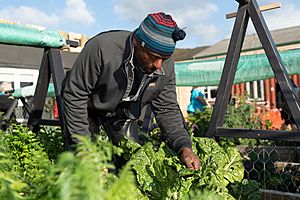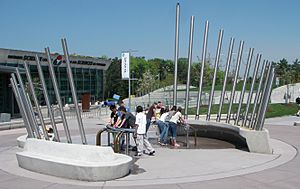Public art facts for kids
Public art is artwork made for everyone to see and enjoy. It's often created through a public process, meaning many people are involved in deciding what it will be. This type of art is for the general public and is usually found in public spaces, both outdoors and indoors. It aims to share ideas that are important to everyone, not just for business or personal reasons. Public art is also often made, bought, or kept up with public support.
Sometimes, art made in public places, like graffiti or street art, isn't officially called public art. This is because it might not go through a public process or get official approval. However, this idea is slowly changing as more people recognize the value of street art.
Contents
What Makes Art Public?
Public art has several common features. It's easy for people to see and get to. It's placed in public areas, and the community often helps create it. It also usually involves a public process, which can include public money. These artworks can be permanent or temporary. Art expert Mary Jane Jacob says that public art helps bring art closer to everyday life.
Easy to See: Art in Public Places
Public art is made so that everyone can see it, either by looking at it or by being able to walk up to it. Even if public art is on private land, people usually still have the right to see it.
Public art is often "site-specific." This means the artwork is made especially for the place and community where it will be. It connects its message to the people around it. Art expert Cher Krause Knight explains that art is "public" when it connects with its audience. It gives people a chance to think and talk about social ideas, but it lets them form their own opinions.
Public Process and Funding
Public art often involves the community working together. Artists and organizations often team up with architects, builders, local residents, leaders, and funding groups.
Public art is often part of official "art in public places" programs. These programs might also include art education or performances for the community. Governments often pay for these programs through "Percent for art" initiatives. This means a small part of the money for new public buildings goes towards art.
How Long Does Public Art Last?
Some public art is made to be strong and last a long time. Because it's outside or in public places, it needs to be made from safe and tough materials. Public artworks are built to handle weather like sun, wind, and rain, as well as people interacting with them. In the United States, public art is protected by a law called the Visual Artists Rights Act of 1990 (VARA). This law means public art can't just be sold or removed easily, unlike art in galleries or museums.
Types of Public Art
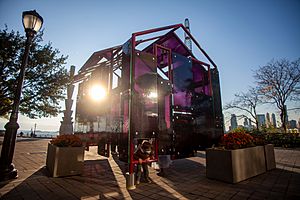
Public art can be connected to its surroundings in different ways. These types often overlap and use different kinds of art to fit their environment.
- Stand-alone: These are artworks that stand by themselves. Examples include sculptures, statues, or other structures.
- Integrated: This art is built into buildings, sidewalks, or landscapes. Think of bas reliefs (sculptures that stick out from a flat surface), mosaics, or digital lights.
- Applied: This art is put onto a surface. Examples are murals (paintings on walls) or sculptures attached to buildings.
- Installation: Here, the artwork and its location are deeply connected. Art in a train station is a good example.
- Ephemeral: These artworks are temporary and don't last forever. This could be a performance, a temporary sculpture like a stack of balanced rocks, or even colored smoke.
History of Public Art
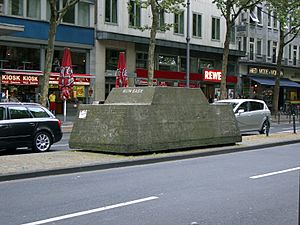
Public Art in the United States (1900s)
In the 1930s, the United States started programs to create art for the public. President Roosevelt's New Deal programs helped public art grow during the Great Depression. These programs aimed to make Americans proud of their culture and make art available to everyone. The "Art-in-Architecture" (A-i-A) program, for example, set aside a small percentage of money from government building projects to buy art. This helped make sure that public art in the U.S. truly belonged to the public and was often made for specific locations.
In the 1970s, public art changed a lot. After the civil rights movement, people started thinking differently about public spaces. Public art became more than just decoration; it became about the public itself. Organizations like the Public Art Fund in New York helped this change. Artists also started focusing on creating art for specific places, rather than just for museums.
Art for the Environment
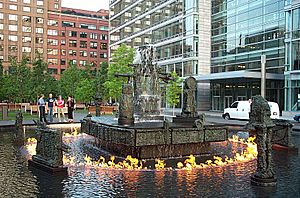
From the 1970s to the 1980s, public art also started to focus on environmental issues. Artists like Agnes Denes and Joseph Beuys created projects to make people more aware of nature. Denes planted a two-acre field of wheat in downtown Manhattan. Beuys planted 7000 oak trees in Germany. Both projects aimed to encourage green urban design. Today, programs that turn old, empty lots into green spaces often include public art. Examples include the High Line in New York City and Gleisdreieck Park in Berlin, which both feature outdoor art.
The 1980s also saw more sculpture parks being created. These parks provided a good home for large sculptures that were too big for museums. Places like Noguchi's garden in Queens, New York, show the importance of art staying in a permanent relationship with its location.
Public Art and Sustainability
Public art faces a challenge: how to make its surroundings more lively. "Sustainable development" is about meeting our needs today without harming the ability of future generations to meet their own needs. It includes economic, social, and environmental parts. Sustainable public art would include plans for improving cities and even taking the art apart responsibly.
An example is the "Mission Leopard" artwork in India in 2016. Artists painted two leopards on a tall water tank to raise awareness about living with wildlife and protecting the environment.
Ron Finley, known as the "Gangsta Gardener," creates temporary public art in South Central L.A. by planting public food gardens. This helps with sustainability and makes sure people have access to healthy food.
Art You Can Interact With
Some public art is made for people to touch and play with. This can include art with music, lights, video, or water. For example, a sculpture by Steve Mann at the Ontario Science Centre is a musical instrument called a hydraulophone. People can make sounds by blocking water jets.
Another example is Rebecca Hackemann's "The Public Utteraton Machines." These machines record what people think about other public art in New York and share the responses online.

New Kinds of Public Art
In the 1990s, some artists started making art that directly helped social causes in public spaces. This was called "new genre public art." It's also known as "relational art" or "community-based art." Suzanne Lacy describes it as "socially engaged, interactive art for diverse audiences with connections to identity politics and social activism."
An example is Mel Chin's Fundred Dollar Bill Project, which is an interactive project about social action. Instead of just showing social problems, this new art aimed to help groups that were often ignored, while still looking good. The 1993 art show "Culture in Action" by curator Mary Jane Jacob looked at social systems by working with people who usually didn't go to art museums.
Curated Public Art
"Curated public art" is art that a community or the public helps to "commission" (ask an artist to create). This often happens with the help of a curator, who acts as a go-between. The doual'art project in Douala, Cameroon, is an example. It brings together the community, the artist, and the organization that ordered the art to create a project.
Memorial Public Art
Public art is often used to remember people, groups, or important events. Examples include Maya Lin's Vietnam Veterans Memorial in Washington D.C., Tim Tate's New Orleans AIDS Monument, and Kenzō Tange's Cenotaph for the A-bomb Victims in Hiroshima, Japan.
Finding Public Art Online
Since the 1990s and 2000s, many online lists of local and regional public art have appeared. These online databases can be general or focus on specific types of art, like sculptures or murals. They can be run by governments, government-like groups, or independent organizations.
The Smithsonian American Art Museum's Archives of American Art has over six thousand artworks in its database. Many other non-government groups and schools also keep online lists of public artworks. These include the National Endowment for the Arts and the Public Art Fund. Public Art Online focuses on art in the UK, and the Institute for Public Art has information about art on six continents.
The WikiProject Public art started in 2009 to document public art around the world.
See also
 In Spanish: Arte público para niños
In Spanish: Arte público para niños



